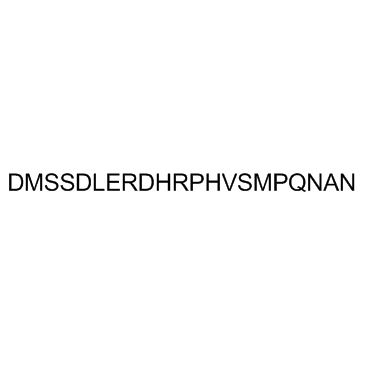Calcitonin C-Terminal Flanking Peptide (human) trifluoroacetate salt
Modify Date: 2024-01-02 08:10:15

Calcitonin C-Terminal Flanking Peptide (human) trifluoroacetate salt structure
|
Common Name | Calcitonin C-Terminal Flanking Peptide (human) trifluoroacetate salt | ||
|---|---|---|---|---|
| CAS Number | 85916-47-8 | Molecular Weight | 2436.60000 | |
| Density | N/A | Boiling Point | N/A | |
| Molecular Formula | C97H154N34O36S2 | Melting Point | N/A | |
| MSDS | N/A | Flash Point | N/A | |
Use of Calcitonin C-Terminal Flanking Peptide (human) trifluoroacetate saltKatacalcin is a second potent plasma calcium-lowering peptide. |
| Name | Katacalcin |
|---|---|
| Synonym | More Synonyms |
| Description | Katacalcin is a second potent plasma calcium-lowering peptide. |
|---|---|
| Related Catalog | |
| In Vitro | Katacalcin is a potent plasma calcium lowering peptide. Katacalcin belongs to the calcitonin family, that causes a rapid but short-lived drop in the level of calcium and phosphate in blood by promoting the incorporation of these ions in the bones[1]. Katacalcin (KC) belongs to a small family of polypeptides that are encoded by the calc-1 gene and also include calcitonin (CT) and procalcitonin NH2-terminal cleavage peptide (N-ProCT). Katacalcin pretreatment leads to a concentration-dependent decrease at concentrations between 1 amol/liter and 10 fmol/liter and is a more potent inhibitor of fMLP-induced chemotaxis than CT or procalcitonin (PCT). Katacalcin deactivates CD14+ peripheral blood mononuclear cell (PBMC) chemotaxis not only toward N-formyl-Met-Leu-Phe (fMLP) but also toward other attractants of the chemokine family (heterologous deactivation) as well as toward PCT and CT. Pretreatment of CD14+ PBMCs with Katacalcin also deactivates subsequent chemotaxis toward Katacalcin itself. Katacalcin elicites concentration-dependent migration of CD14+ PBMC at concentrations from the atomolar to the micromolar range and deactivates attractant-induced chemotaxis. Katacalcin regulates human CD14+ PBMC migration via signaling events involving protein kinase A-dependent cAMP pathways[2]. |
| Kinase Assay | Leukocyte migration is measured using a modified 48-blind well microchemotaxis chamber equipped with 5 μm pore-sized nitrocellulose filters for CD14+ PBMC chemotaxis. In some experiments cells are incubated for 20 minutes with GFX (500 nM), Staurosporine (10 ng/mL), Tyrphostin-23 (10 ng/mL), Wortmannin (WTN) (10 nmol/liter), Protein kinase A inhibitor (PKI) (from 0.1 to 100 ng/mL) or Rp-cAMPS (from 100 pM to 100 μM), or CTX (1 nM) or pertussis toxin (PTX) (1 nM). For determination of Katacalcin 's potency to deactivate CD14+ PBMC chemotaxis toward fMLP, cells are incubated with Katacalcin (from 1 amol/liter to 1 μmol/liter) for 20 minutes. For control, cAMP-independent migration of CD14+ PBMC toward bombesin is tested in some of the experiments. After washing twice, 50 μL of a cell suspension (1×106 cells/mL) is put into the upper compartment of the chemotaxis chamber and cells are allowed to migrate for 90 minutes toward peptides derived from the calc-1 gene in the lower wells. After these migration periods, the filters are dehydrated, fixed, and stained with hematoxylin and eosin. Migration depth is quantified by microscopy, measuring the distance from the surface of the filter to the leading front of three cells migration[2]. |
| References |
| Molecular Formula | C97H154N34O36S2 |
|---|---|
| Molecular Weight | 2436.60000 |
| Exact Mass | 2435.07000 |
| PSA | 1198.66000 |
| Storage condition | 2-8℃ |
| Pdn-21 |
| Calcitonin carboxyl-terminal flanking peptide |
| hCCAP |
| CCP I |
| Human ccap |
| CCAP |
| Peptide (aspartic acid-asparagine) |
| Preprocalcitonin carboxyl-terminal region peptide |

